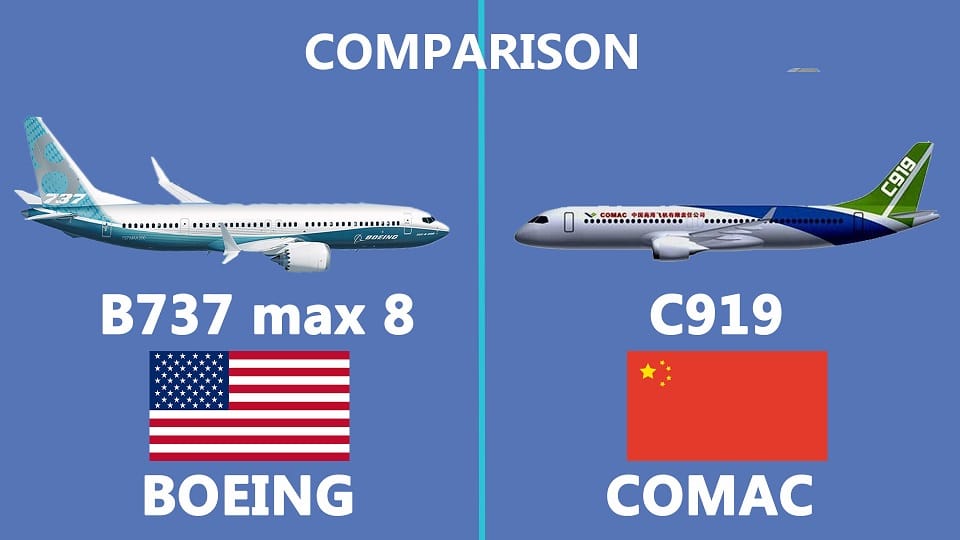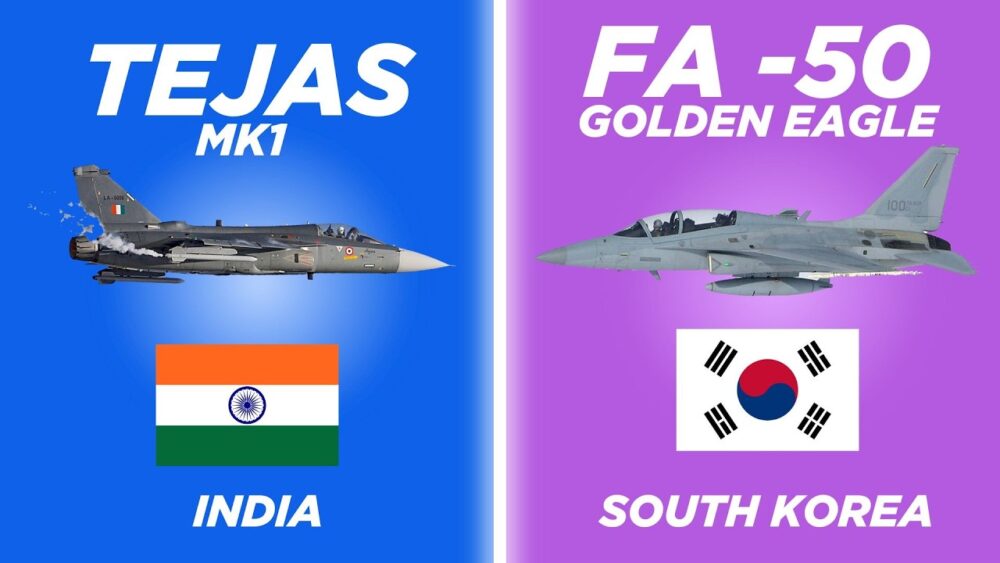Aircraft comparison
Aircraft comparisons between the Chinese-built comac C919 and the Boeing 737 max 8

In this post, we’ll compare two narrow-body aircraft, one from the United States (the Boeing 737 Max 8 aircraft) and one from China (the Comac C919 aircraft), which was just domestically manufactured.
China is seeking a larger market to supply its aircraft to domestic and foreign customers. Eastern China Airlines has recently received delivery of its first aircraft. With regard to its Boeing 737 segment of aircraft, Boeing already holds the largest market share. Undoubtedly, if the Comac aircraft becomes widely used, Boeing may lose market share in China.
Let’s analyze the specifications of both aircraft.
Boeing B737-8.
The Boeing 737 MAX is the fourth generation of the Boeing 737, a narrow-body airliner manufactured by Boeing Commercial Airplanes (BCA), a division of the American company Boeing. The first MAX 8 was delivered in May 2017 to Malindo Air, which began using it on May 22, 2017. A MAX 8 carrying 162 passengers on a 3,000 nautical mile (5,600 km) flight is anticipated to burn 1.8 percent less fuel than an airplane with blended winglets.
Compared to the A320neo, the MAX 8 is heavier at takeoff and has a lower empty weight. During a test flight for Aviation Week, the aircraft was flying at a less-than-ideal height while cruising at a real airspeed of 449 knots (832 km/h) and weighing 140,500 pounds (63,700 kg). The Boeing 737 MAX 8 completed its first flight test in La Paz, Bolivia. The 13,300-foot altitude at El Alto International Airport tested the MAX’s capability to take off and land at high altitudes.
In early 2017, a new B737-8 was valued at $52.85 million, rising to below $54.5 million by mid-2018, and the latest version is having a 200 Seater variant under construction for Ryanair. With a 160-passenger capacity, the 737-8 has so far been the most popular model.
Comac C919
A narrow-body airliner called the Comac C919 was created by the Chinese company Comac, and it had its inaugural flight on May 5, 2017. Not early than 2022 or 2023 is anticipated for the first commercial deliveries of the aircraft to China Eastern Airlines. Comac had 1008 pledges as of the end of August 2018, including 305 firm orders, many of which came from Chinese leasing companies or airlines.
At Shanghai Pudong International Airport, the C919 successfully completed its first pre-delivery flight test. According to Comac, the aircraft successfully finished a three-hour test session on May 14, 2022. This year will see the delivery of the aircraft in the livery of the Chinese company OTT Airlines, a division of China Eastern. The aircraft was listed in May 2022 for 653 million yuan (US$95 million), nearly matching the prices of the Airbus A320neo and Boeing 737 Max rivals and more than double the earlier estimate of US$50 million.
How the Comac C919 similar from the A320 and B737 Max.(Opens in a new browser tab)
The C919 has a lower maximum fuel capacity than the A320 and 737-800, As a result, the normal variant’s range is only 2,200 nm and the extended range variants is 3,000 nm, respectively. Because the C919 was built to accommodate more passengers than the Boeing 737-800 in a standard all-economy configuration, COMAC was able to expand the fuel capacity and, consequently, the range of the aircraft.
China certifies C919 jet to compete with Airbus and Boeing(Opens in a new browser tab)
Here are some of the differences between the Boeing 737-8 and the Comac C919:
- Manufacturing: The Boeing 737-8 is manufactured by Boeing, a US-based aerospace corporation, while the Commercial Aircraft Corporation of China (COMAC), a Chinese state-owned aircraft manufacturer, the Comac C919.
- History: The Boeing 737 is a well-known aircraft model that has been in service for almost 50 years, whereas the Comac C919 is a newer aircraft that is currently in development.
- Size: The Comac C919 is slightly smaller than the Boeing 737-8, with a seating capacity of up to 210 people compared to the 737-8’s 174 seats.
- Range: The Boeing 737-8 has a range of about 6,570 km (3,550 nmi), whereas the Comac C919 has a range of about 5,576 km (3,011 nmi)
- Engines: The Boeing 737-8 is powered by CFM International LEAP engines, while the Comac C919 is powered by CFM International LEAP-1C engines.
- Cost: The Comac C919 is generally considered to be less expensive than the Boeing 737-8, with a list price of approximately $95 million compared to the $99.7 million list price of the 737-8.
- Orders: The Boeing 737-8 has over 5,800 orders from airlines all over the world, while the Comac C919 has over 800 orders.
- Customers: The Boeing 737-8 is used by various airlines, including several major worldwide carriers, but the Comac C919 is mostly used by Chinese airlines.
- Certification: The Boeing 737-8 has been certified by aviation authorities worldwide, including the Federal Aviation Administration (FAA) in the United States and the European Aviation Safety Agency (EASA), while the Comac C919 is still in the certification process.
- Performance: The Boeing 737-8 has a proven track record of reliability and performance, but the Comac C919 is still in the midst of demonstrating its potential.
| Specifications | B737-8 | C919 |
| Length | 129 ft (39.47 m) | 127.6 ft (38.9 m) |
| Wingspan | 117 ft (35.92m) | 117.5 ft (35.8 m) |
| MTOW | 182,200 lb (82,600 kg) | 159,835 lb (72,500 kg) |
| Maximum Payload | 46,040 lb (20,880 kg) | 45,000 lb (20,400 kg) |
| Range | 3,550 nmi (6,570 km) | 2,200 nmi (4,075 km) |
| Cruise | Mach 0.79 (453 kn; 839 km/h) | Mach 0.785 (450 kn; 834 km/h) |
| Takeoff | 8,300 ft (2,500 m) | 6,600 ft (2,000 m) |
| Landing | 5,000 ft (1,500 m) | 5,200 ft (1,600 m) |
| height | 40 ft (12.29m) | 39.2 ft (11.95 m) |

Aircraft comparison
Comparison of the Indian built Tejas MK1A vs South korean FA 50

Today, we’ll explore two remarkable light combat aircraft: the Tejas MK1A and the FA-50 Golden Eagle. Both fighters are designed for versatility, making them ideal for various missions, from air-to-air combat to ground support.
The Tejas MK1A, developed by Hindustan Aeronautics Limited (HAL) in India, and the FA-50, a product of Korea Aerospace Industries (KAI), are both advanced aircraft equipped with modern technology and features.
10 Fascinating Facts About India’s AMCA Fighter Jet
In this Article, we will compare these two fighters in terms of their specifications, performance, capabilities, and roles in modern air forces. Let’s dive in and see how they stack up against each other!
Tejas is the second supersonic combat aircraft developed by Hindustan Aeronautics Limited (HAL), following the HF-24 Marut. It took its first flight in 2001 and was inducted into service with the Indian Air Force (IAF) in 2015. Currently, Tejas holds the distinction of being the smallest and lightest aircraft in its class of supersonic combat jets.
On the other hand, the FA-50 is South Korea’s first indigenous supersonic aircraft and is one of the few supersonic trainers in the world. Development of the T-50 began in the late 1990s, with its maiden flight taking place in 2002.
Russia Seeks Talks with India, Offers Tu-160 Bombers at Unbeatable Prices
The FA-50 boasts a higher production rate compared to the Tejas. Over the past 15 years, Korea Aerospace Industries (KAI) has produced nearly 200 variants of the FA-50, while Tejas has seen a lower production output.
In terms of international sales, the FA-50 is actively in service with multiple countries, including Indonesia, Iraq, the Philippines, Thailand, and Poland. Notably, Malaysia opted for the FA-50 over the Tejas, citing the FA-50’s strong service record as a key factor in their decision.
Here’s a SPECIFICATION of the Tejas and FA-50
Length: The Tejas measures 13.2 m (43 ft 4 in), making it slightly longer than the FA-50, which is 13.14 m (43 ft 1 in).
Max Takeoff Weight: The Tejas has a maximum takeoff weight of 13,500 kg (29,762 lb), compared to the FA-50’s lighter weight of 10,722 kg (23,638 lb).
Fuel Capacity: The Tejas has an internal fuel capacity of 3,060 liters (810 US gallons), while the FA-50 has a slightly lower internal fuel capacity of 2,655 liters (701 US gallons).
Powerplant: Both aircraft are powered by General Electric F404 turbofan engines, but the Tejas utilizes the F404-GE-IN20 variant with 48.9 kN (11,000 lbf) thrust dry and 85 kN (19,000 lbf) with afterburner. The FA-50 features the F404-GE-102 variant, producing 53.07 kN (11,930 lbf) thrust dry and 78.7 kN (17,700 lbf) with afterburner.
Maximum Speed: The Tejas has a maximum speed of 2,220 km/h (Mach 1.8), which is significantly faster than the FA-50’s maximum speed of 1,837.5 km/h (Mach 1.5).
Combat Range: The Tejas has a combat range of 739 km (459 mi), whereas the FA-50 has a much longer range of 1,851 km (1,150 mi).
Hardpoints: The Tejas features 9 hardpoints with a total capacity of 5,300 kg, while the FA-50 has 7 hardpoints capable of carrying up to 5,400 kg of payload.
Cost: The Tejas is priced at approximately $40 million per unit, whereas the FA-50 ranges between $30 million to $40 million per unit, making the FA-50 potentially more cost-effective depending on the variant chosen.
Weapons
When it comes to weaponry, the Tejas MK1A offers a wider range of options compared to the FA-50 Golden Eagle. The Tejas MK1A is equipped with beyond-visual-range (BVR) missiles, allowing it to engage targets at greater distances, enhancing its combat effectiveness in air superiority missions. Additionally, it can carry precision-guided munitions for accurate strikes against ground targets, as well as standoff weapons, which can be launched from a distance to minimize exposure to enemy defenses. This diverse armament enables the Tejas to perform a variety of roles, from air-to-air combat to ground support.
In contrast, the FA-50 also features a respectable armament capability but has a more limited selection. It can carry air-to-air missiles like the AIM-9 Sidewinder and AIM-120 AMRAAM, as well as precision-guided bombs. However, its focus leans more toward close air support and light strike missions rather than the extensive versatility that the Tejas offers.
Naval Variant
The Tejas Mk1A has a naval variant designed for carrier operations, which is still in development. This version includes upgrades like a nose droop for better visibility during landings and takeoffs, a strengthened undercarriage, and an arrestor hook for safe landings on aircraft carriers.
In contrast, the FA-50 does not have a naval variant. While it’s versatile for different missions, it’s not designed for carrier operations, limiting its flexibility compared to the naval Tejas, which can operate from both land and carriers.
-

 Aviation2 months ago
Aviation2 months agoMicrosoft Flight Simulator Raises $3 Million to Bring Back the An-225 Mriya
-

 Airlines2 months ago
Airlines2 months agoQantas Engineers Stage Walkout Over Cost of Living Concerns
-

 Airlines2 months ago
Airlines2 months agoQatar Citizens Can Travel to the United States Without a Visa
-

 Aviation2 months ago
Aviation2 months agoQatar Airways bans these new Electronic Devices on plane
-

 Airlines2 months ago
Airlines2 months agoJapan Airlines Rolls Out Free Domestic Flights to International Passengers
-

 Defence2 months ago
Defence2 months agoWhich Country Has the Largest Fleet of Fighter Aircraft?
-

 Airport2 months ago
Airport2 months agoWestern Sydney Airport Welcomes Its First Plane After 6 Years of construction
-

 Aviation2 months ago
Aviation2 months agoDid you know ? Once Boeing 747 carried 1088 passenger in 1991








